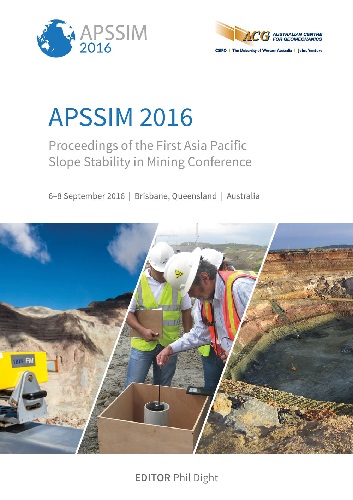Hybrid rockfall barrier — new design methodology based on the Colorado full-scale test experience

|
Authors: Cerro, M; Giacchetti, G; Lelli, M; Grimod, A; Arul, A |
DOI https://doi.org/10.36487/ACG_rep/1604_24_Cerro
Cite As:
Cerro, M, Giacchetti, G, Lelli, M, Grimod, A & Arul, A 2016, 'Hybrid rockfall barrier — new design methodology based on the Colorado full-scale test experience ', in PM Dight (ed.), APSSIM 2016: Proceedings of the First Asia Pacific Slope Stability in Mining Conference, Australian Centre for Geomechanics, Perth, pp. 393-406, https://doi.org/10.36487/ACG_rep/1604_24_Cerro
Abstract:
Hybrid rockfall barriers combine the energy absorption capabilities of a dynamic rockfall barrier with the reduced-maintenance advantages of drapery mesh. The aim of this innovative design is not to capture and stop the falling rocks, as the barriers tested according to ETAG 027 (EOTA 2008), but to contain the bounce of the rock and to drive it down the slope beneath the mesh draped down the slope face. Although this type of rockfall structure has already been applied worldwide, there is still a lack of knowledge in the design methodology. The purpose of this paper is to present a simplified model to design hybrid barriers based on the field experiences and research carried out by the Colorado Department of Transportation, “Colorado’s full-scale field testing of rockfall attenuator system" (Arndt et al. 2009), giving designers a tool for sizing both the structure in elevation that the interception structure (net) and assessing the forces transmitted to the foundations.
Keywords: hybrid rockfall barrier
References:
Arndt, B, Ortiz, T & Turner, AK 2009, ‘Colorado’s full-scale field testing of rockfall attenuator systems’, Transportation Research Circular E-C141, prepared for the Transportation Research Board, sponsored by the Colorado Department of Transportation (CDOT).
Badger, TC 2007, ‘Suspended Draped Rockfall Protection: An Overview of System Performance in Washington’, Association of Environmental & Engineering Geologists – Program with abstracts, p. 68.
Badger, TC, Duffy, JD, Sassudelli, F, Ingraham, PC, Perreault, P, Muhunthan, B, Radhakrishnan, H, Bursi, OS, Molinari, M & Castelli, E 2008, ‘Hybrid Barrier Systems for Rockfall Protection’, Workshop on Rockfall Protection, Morschach, Switzerland.
Chai, S, Yacoub, T, Charbonneau, K & Curran, JJ 2013, ‘The effect of rigid body impact mechanics on tangential coefficient of restitution’, GeoMontreal 2013, Montreal.
Duffy, JD 2007, ‘Hybrid Rockfall Systems’, Association of Environmental & Engineering Geologists — Program with abstracts, p. 80.
EN 1997, ‘Eurocode 7: Geotechnical design – Part 1: General rules’, European Committee for Standardization (CEN).
EOTA (European Organisation for Technical Approval) 2008, ETAG 027: Guideline for European technical approval of falling rock protection kits, Brussels, www.eota.be
Muhunthan, B, Shu, S, Sashiharan, N, Hattamleh, OA, Badger, TC, Lowell, SL & Duffy, JD 2005, ‘Analysis and Design or Wire Mesh/Cable Net Slope Protection’, Washington State Transportation Centre, Seattle, WA-RD 612.1, 267, p. 6.
Smerekanicz, JR, Ingraham, PC, Brandon, PE, Hee, BH, Cajigal, FM & Journeaux, DL 2008, ‘Rock Slope Stabilization Measures at the Pali Tunnel Route 30, Maui, Hawai’, 59th Highway Geology Symposium, p. 9.
Sussadelli, F, Perreault, P & Ingraham, PC 2007, ‘Recent rockfall barrier testing in Italy: structural component test and dynamic testing of barrier kits and hybrid barrier/drape system in the framework of European technical guidelines’, Program with Abstracts — 50th Annual Meeting of the Association of Environmental and Engineering Geologists, Los Angeles, p. 122.
Tuner, AK & Schuster, RL 2013, ‘Rockfall characterization and control’, Transportation Research Board (TRB).
© Copyright 2024, Australian Centre for Geomechanics (ACG), The University of Western Australia. All rights reserved.
View copyright/legal information
Please direct any queries or error reports to repository-acg@uwa.edu.au
View copyright/legal information
Please direct any queries or error reports to repository-acg@uwa.edu.au